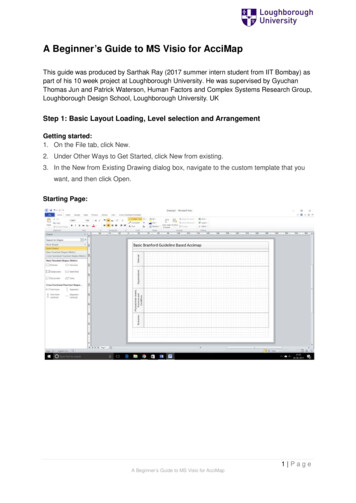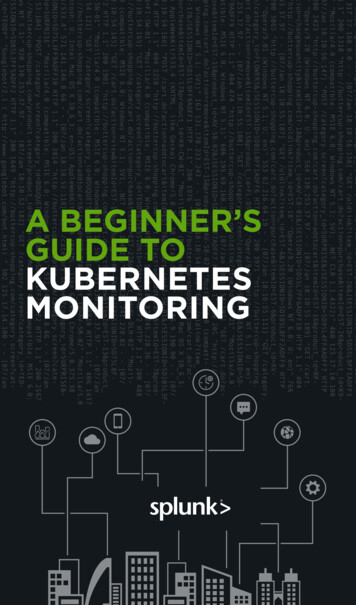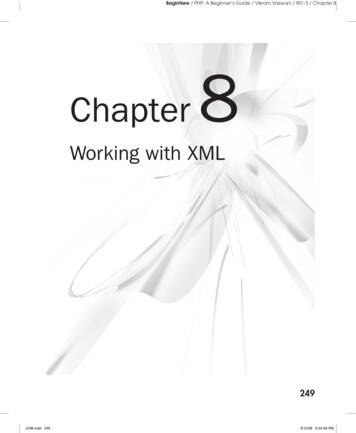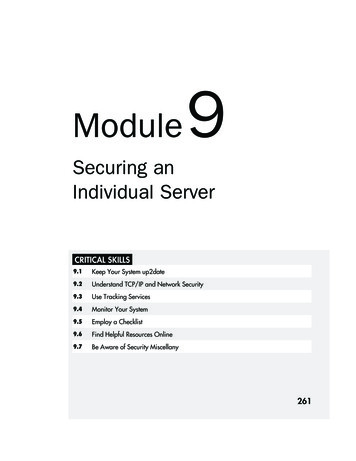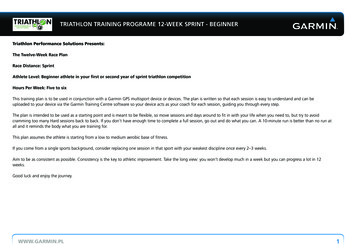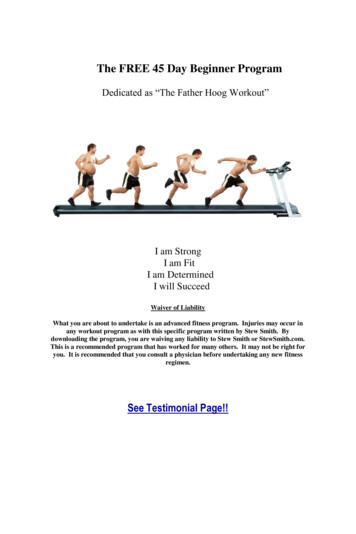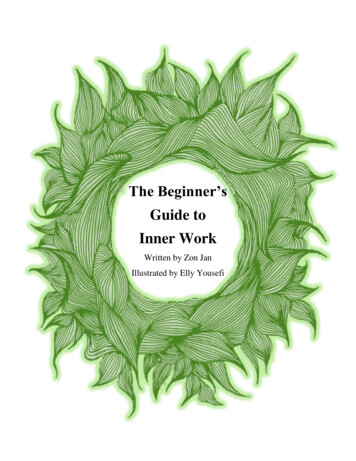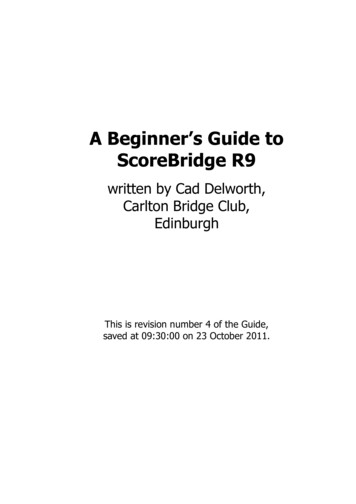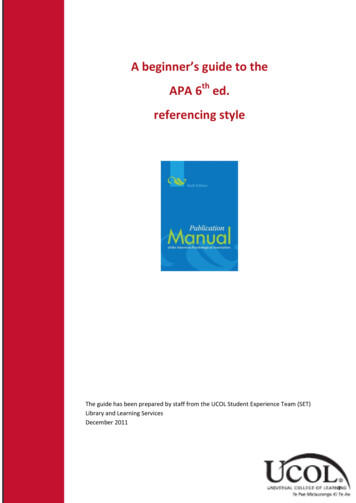
Transcription
Beginners Guide to APA referencing - 6th editionA beginner’s guide to theAPA 6th ed.referencing styleThe guide has been prepared by staff from the UCOL Student Experience Team (SET)Library and Learning ServicesDecember 20111
Beginners Guide to APA referencing - 6th edition2
Beginners Guide to APA referencing - 6th editionContentsWhat is APA? . 5Why reference? . 5How to reference . 61. In text citations . 61.1.Three, four or five authors . 71.2.Six or seven authors . 71.3.Eight or more authors . 71.4.Groups as authors . 81.5.Similar information referred to by more than one author . 81.6.Citing a secondary source . 92. Direct quotes . 92.1.Short quote – less than 40 words . 92.2.Longer quote – 40 words or more . 102.3.Quotations from online resources that do not provide page numbers . 103. The reference list . 113.1.Books . 123.2.Book – one author. 123.3.Book – place of publication. 123.4.Book – editor . 123.5.Book – editors & edition . 133.6.Book – author & publisher are the same . 133.7.Chapter in an edited book . 133.8.Serial/journal articles . 133.9.Serial / journal article (print). 133.10.Serial / journal article – more than one author (print) . 133.11.Serial / journal article (online from a database – e.g. EBSCO or Newztext) . 143.12.Serial / journal – more than one author (online– DOI) . 143.13.Serial / Journal article – 8 or more authors (online – no DOI) . 143.14.Internet sources . 153.15.Internet – no author, no date . 153.16.Internet – Organisation / Corporate author . 153
Beginners Guide to APA referencing - 6th edition4. Examples of various types of information sources . 164.1.Act (statute / legislation) . 164.2.Blog post . 164.3.Brochure / pamphlet. 164.4.Brochure / pamphlet (no author) . 164.5.Clickview . 174.6.Conference Paper . 174.7.Conference paper (online) . 174.8.Dictionary (print) . 174.9.Dictionary (online) . 184.10.Specific entry in an online dictionary (no author or editor) . 184.11.Specific entry in an online dictionary (editor). 184.12.DVD / Video / Motion Picture (including Clickview & Youtube) . 184.13.e-book (including Safari and Google books) . 194.14.Magazine . 194.15.Moodle . 194.16.Music recording (Whole album) . 194.17.Music recording (Song from album) . 204.18.Newspaper article . 204.19.Newspaper article (no author) . 204.20.Newspaper (online) . 204.21.Personal communication . 204.22.Podcast (audio or video) . 214.23.Software (including apps) . 214.24.Television programme . 214.25.Thesis (print) . 214.26.Thesis (online) . 214.27.Wikis (including Wikipedia) . 214.28.Youtube see – DVD / Video / Motion picture . 215. Reference List . 224
Beginners Guide to APA referencing - 6th editionWhat is APA?Your assignment states – Please reference using the APA style - 6th ed. You think to yourself .“Arrrgghhh. what does that mean, why do I have to do it and how do I do it!?”APA is one of many referencing styles used in academic writing. APA stands for AmericanPsychological Association. The Association outlines the style in the Publication manual of theAmerican Psychological Association [APA] (6th ed.).UCOL programmes utilise the APA referencing style.There are many different referencing styles (over 100). It is essential to follow the style specified inyour assignments and not to mix styles. Consistency of style is important!Why reference?When you reference you use the standardised style to acknowledge the source of information usedin your assignment.It is important (morally & legally) to acknowledge someone else’s ideas or words you have used.Academic writing encourages paraphrasing information you have researched and read.Paraphrasing means re-wording something you have read in to your own words. If you use someoneelse’s words or work and fail to acknowledge them – you may be accused of plagiarism andinfringing copyright.Referencing correctly enables the marker or reader of your assignment to locate the source of theinformation. They can verify the information or read further on the topic.Referencing also allows for you to retrace your steps and locate information you have used forassignments and discover further views or ideas discussed by the author.By referencing clearly and correctly, it demonstrates you have undertaken research on theassignment topic and located relevant information.There are two main parts to referencing:1. The first indicating within your assignment the sources of the information you have used towrite your assignment. This demonstrates support for your ideas, arguments and views.Sometimes this is referred to as: citing in text, in text citations or text citations2. The second part to referencing is the construction of a reference list. The reference listshows the complete details of everything you cited and appears in an alphabetical list on aseparate page, at the end of your assignment.Tip: Everything you have cited in text appears in your reference list and likewise. everything thatappears in your reference list will have been cited in text! Check this is the case prior to handing inyour assignment. (The exception is when using a personal communication. Personal communicationsare cited in text but do not appear in the reference list. See page 20.)5
Beginners Guide to APA referencing - 6th editionThe following guide provides some general rules and examples using the 6th ed. of APA.For further information and help: Refer to the Publication manual of the American Psychological Association (6th ed.) [fromhere on referred to as the APA manual], especially chapters 6 & 7.Copies are available at the UCOL Library, some for borrowing, some on Desk reserve. [Shelfnumber: 808.027 PUB]Student Experience Team members (Learning Services & Library staff) are available to assistwith referencingSee the APAstyle website ( http://www.apastyle.org/)Plus there are APA wizards freely available online and Microsoft Word provides a built-inreferencing function (Note: some editing maybe required when using these tools)How to reference1. In text citationsEven though you have put someone else’s ideas or information in your own words (i.e.paraphrased), you still need to show where the original idea or information came from. This is allpart of the academic writing process.When citing in text with in an assignment, use the author/s (or editor/s) last name followed by theyear of publication.Example:Water is a necessary part of every person’s diet and of all the nutrients a body needs to function, itrequires more water each day than any other nutrient (Whitney & Rolfes, 2011).orWhitney and Rolfes (2011) state the body requires many nutrients to function but highlight thatwater is of greater importance than any other nutrient.orWater is an essential element of anyone’s diet and Whitney and Rolfes (2011) emphasise it is moreimportant than any other nutrient.Reference list entry:Whitney, E., & Rolfes, S. (2011). Understanding nutrition (12th ed.). Australia: Wadsworth CengageLearning.Note: this book did not have a city for place of publication, just a country.6
Beginners Guide to APA referencing - 6th edition1.1. Three, four or five authorsIf a work has three (3), four (4) or five (5) authors, cite all authors the first time and from then oninclude only the last name of the first author followed by the words et al. (‘et al.’ is Latin for ‘andothers’)Example:Research can be defined as a systematic method of creating new knowledge or a way to verifyexisting knowledge (Watson, McKenna, Cowman & Keady, 2008).Deciding on a research method demands the researcher consider carefully the problem or area ofinvestigation being researched (Watson et al., 2008).Reference list entry:Watson, R., McKenna, H., Cowman, S., & Keady, K. (Eds.). (2008). Nursing reseach: Designs andmethods. Edinburgh, Scotland: Churchill Livingstone Elsevier.Note: The people were identified as the editors, hence ‘(Eds.)’ is a shortened version of Editors.1.2. Six or seven authorsIf a work has six (6) or more authors, cite only the last name of the first author followed by et al.each time you refer to this work.Example:(Mikosch et al., 2010)Reference list entry:When a source has up to seven (7) authors, include all names in the reference list.Mikosch, P., Hadrawa, T., Laubreiter, K., Brandl, J., Pilz, J., Stettner, H., & Grimm, G. (2010).Effectiveness of respiratory-sinus-arrhythmia biofeedback on state-anxiety in patientsundergoing coronary angiography. Journal of Advanced Nursing, 66(5), 1101-1110.1.3. Eight or more authorsWhen there are eight (8) or more authors, cite only the last name of the first author followed by ‘etal.’ each time you refer to this work.Example:(Vissing et al., 2004)Note in the reference list: When there are eight (8) or more authors, include the first six (6) authorsnames and then use ellipsis points (.) before concluding with the last author’s name.7
Beginners Guide to APA referencing - 6th editionReference list entry:Vissing, K., Brink, M., Lonbro, S., Sorensen, H., Overgaard, K., Danborg, K., . Aagaard, P. (2008).Muscle adaptations to plyometric vs. resistance training in untrained young men. Journal ofStrength and Conditioning Research, 22(6), 1799-1810.1.4. Groups as authorsThe names of groups that serve as authors (e.g., corporations, associations, government agencies)are usually written in full each time they appear in a text citation. The names of some group authors(e.g., associations, government agencies) are spelled out in the first citation and abbreviatedthereafter. In deciding whether to abbreviate the name of a group author, use the general rule thatyou need to give enough information in the text citation for the reader to locate the entry in thereference list without difficulty. Some groups are recognised by an abbreviation (e.g., WHO forWorld Health Organisation). Refer to the APA manual, 2010, p. 176.First text citation:(Ministry of Health [MOH], 2007).Second & subsequent citations:(MOH, 2007).Reference list entry:Ministry of Health. (2007). Looking at long-term residential care in a rest home or hospital: What youneed to know. Wellington, New Zealand: Author.Note: If the author and publisher are the same – Author – can be used to indicate the publisher inplace of the full name. See the example above.Group as author no abbreviationNew Zealand House of Representatives, Health Committee. (2007, August). Inquiry into obesity andtype 2 diabetes in New Zealand: Report presented to the House of Representatives. Retrievedfrom 2-42EF-A2976AB08980C0EA/61821/DBSCH SCR 3868 5335.pdfIn-text citation:(New Zealand House of Representatives, Health Committee, 2007).1.5. Similar information referred to by more than one authorThere may be occasion to refer to more than one source in relation to similar information. In thiscase, list the sources in alphabetical order within the brackets, separated by a semi-colon.8
Beginners Guide to APA referencing - 6th editionExample:Resilience is seen as the ability to overcome adversary, combat stress and bounce back fromhardship (Dawson, 2006; Overton, 2005).Reference list entry:Dawson, L. (2006). Wise up!: How to be fearless and fulfilled in midlife. Auckland, New Zealand:Random House New Zealand.Overton, A. (2005). Stress less: Make stress work for you not against you. Auckland, New Zealand:Random House New Zealand.1.6. Citing a secondary sourceWhere possible use original material. However, if the information you wish to use is cited by anotherauthor, acknowledge the source you have read, showing it is a secondary source. Thisdemonstrates you have not read the original source but read about it in a secondary source. Withinthe text citation, use the words “as cited in” to indicate this is a secondary source. In the referencelist, include the author and details of the source you actually read. Refer to the APA manual, 2010, p.178.Example:Fawcett (as cited in Polit & Beck, 2008) outlined the four main concepts Reference list entry:Polit, D. F., & Beck, C. T. (2008). Nursing research: Generating and assessing evidence for nursingpractice (8th ed.). Philadelphia, PA: Wolters Kluwer Health/Lippincott Williams & Wilkins.2. Direct quotesQuoting directly from a work should be done sparingly, in order to emphasis or stress a point in youressay. When using a quote, it must be copied exactly as written in the original work including anypunctuation or incorrect spelling. When using a quote, include the author’s last name, year ofpublication and page number/s where the quote appears. Refer to the APA manual, 2010, p. 170173 for further information.2.1. Short quote – less than 40 wordsTo indicate a short quote (less than 40 words), enclose the quotation within double quotation marks.Example:“Cultural safety is based on attitudes which are difficult to measure. It needs to be consideredalongside other equally important safety requirements such as clinical, ethical, legal and physicalsafety” (Wepa, 2005, p. 25).9
Beginners Guide to APA referencing - 6th edition2.2. Longer quote – 40 words or moreFor a quote that is 40 words or more, include it in your essay as a freestanding piece of text or blockform and do not use the quotation marks. Double-space the entire quote. At the end of the quote,include the author’s name, year of publication and page number/s after the full stop.Example:Cultural safety considerations are similar in that students are interacting in a bicultural (twopersoned) context, where they are the giver of a health service and the client is the receiverof that service. These bicultural interactions will be different with every interaction, but thenurse’s awareness of the power differential between themselves and client will be constant.(Wepa, 2005, p. 25)Reference list entry:Wepa, D. (Ed.). (2005). Cultural safety in Aotearoa New Zealand. Auckland, New Zealand: PearsonEducation New Zealand.2.3. Quotations from online resources that do not provide page numbersThe APA manual (2010, p. 171-172) states when using direct quotes from online material provide theauthor, year and page number within brackets ( ). If the page number is not known, use a paragraphnumber.If the paragraph number could confuse the reader, consider including a section heading e.g.discussion section.Example:“The WTN exists to "encourage serendipity" -- the happy accidents of colliding ideas and newrelationships that cause the biggest breakthroughs for individuals and institutions” (WorldTechnology Network, 2010, para. 2).Reference list entry:World Technology Network. (2010). About WTN: The World Technology Network in action. Retrievedfrom http://www.wtn.net/aboutus.html10
Beginners Guide to APA referencing - 6th edition3. The reference listAll references or information sources cited in any written work (i.e. essays, reports, research papers,etc.) need to be listed in a reference list on a separate page at the end of your assignment, headed‘References’ or ‘Reference List’. The reference list provides all the details necessary for the personreading and/or marking the assignment to locate and retrieve any information source cited. Anaccurate and properly constructed reference list provides credibility to the written work itaccompanies.Tip: Everything you have cited in text appears in your reference list and, likewise, everything thatappears in your reference list will have been cited in text! Check this is the case prior to handing inyour assignment. (The exception is when citing a personal communication. Personalcommunications are cited in text but do not appear in the reference list. See example 4.21)Basic rules1. The reference list is arranged in alphabetical order of the authors’ last names.2. If there is more than one work by the same author, order them by publication date – oldestto newest (therefore a 2004 publication would appear before a 2008 publication).3. If there is no author the title moves to that position and the entry is alphabetised by the firstsignificant word, excluding words such as “A” or “The”. If the title is long, it may beshortened when citing in text.4. Use “&” instead of “and” when listing multiple authors of a source.5. The first line of the reference list entry is left-hand justified, while all subsequent lines areconsistently indented.6. Capitalise only the first word of the title and of the subtitle, if there is one, plus any propernames – i. e. only those words that would normally be capitalised.7. Italicise the title of the book, the title of the journal/serial and the title of the webdocument.8. Do not create separate lists for each type of information source. Books, articles, webdocuments, brochures, etc. are all arranged alphabetically in one list.When creating the reference list entry for an information source you need to identify and recordspecific details. It might be useful to remember these Ws!Who – wrote /edited it – author or editorWhen was it written – dateWhat is it – title of book, title of the article & serial/journal, title of the web documentWhere was it published (Books) – place of publication– usually city & country and publisher’s nameWhere was the article located (Serial/journal) - volume number, issue number and page numbersof the articleWhere you located it (Internet sources) - URL – web address11
Beginners Guide to APA referencing - 6th editionThe following are the details for common types of references. The information is usually found onthe title page and the back of the title page of a book. For serials/journals, you will find theinformation included on the article plus the front cover or inside pages of a print serial. Webpagescan take a bit of detective work. You may need to scroll to the bottom of the webpage to find a dateand an author. Refer to the APA manual, 2010, p. 180-192, for further information.3.1. Books1. Author/s or Editor/s last name (surname) appears first, followed by initials (Bloggs, J.).2. Year of publication in brackets (2010).3. Full title of the book. Capitalise only the first word of the title and the subtitle, if any, andproper names. Italicise the title. Use a colon (:) between the title and subtitle.4. Include the edition number, if applicable, in brackets after the title or subtitle (3rd ed.) or(Rev. ed.).Note: No full stop, after the title, if there is an edition.5. Place of publication. Always include the city and 2-letter state code when published insidethe USA, and the city & country, if published outside the USA (Fort Bragg, CA or Auckland,New Zealand or Benalla, Australia or Weybridge, England). If there are two or more placesincluded in the source, then use the first one listed.6. Publisher’s name. Provide this as briefly as possible. Do not use terms such as Publishers,Co., or Inc. but include the words Books & Press. When the author and the publisher are thesame, use the word Author as the name of the publisher.3.2. Book – one authorCollier, A. (2008). The world of tourism and travel. Rosedale, New Zealand: Pearson Education NewZealand.3.3. Book – place of publicationNote: always include the city and 2-letter state code when published inside the USA, and city &country if published outside the USA.Airey, D. (2010). Logo design love: A guide to creating iconic brand identities. Berkeley, CA: NewRiders.Stein, R. (2001). Rick Stein’s seafood. London, England: BBC.3.4. Book – editorWepa, D. (Ed.). (2005). Cultural safety in Aotearoa New Zealand. Auckland, NewZealand: Pearson Education New Zealand.12
Beginners Guide to APA referencing - 6th edition3.5. Book – editors & editionCollins, C., & Jackson, S. (Eds.). (2007). Sport in Aotearoa/New Zealand society (2nd ed.). SouthMelbourne, Australia: Thomson.3.6. Book – author & publisher are the sameMidCentral District Health Board. (2008). District annual plan 2008/09. Palmerston North, NewZealand: Author.3.7. Chapter in an edited bookDear, J., & Underwood, M. (2007). What is the role of exercise in the prevention of back pain? In D.MacAuley & T. Best (Eds.), Evidence-based sports medicine (2nd ed., pp. 257-280). Malden,MA: Blackwell.3.8. Serial/journal articles1. Author/s last name (surname) first, followed by initials.2. Year of publication in brackets. (2012)3. Title of article. Capitalise only the first word of the title and the subtitle, if any, and propernames. Use a colon (:) between the title and subtitle.4. Title of the serial/journal in full in italics.5. Volume number, in italics. Do not use “Vol.” before the number.6. Issue number. This is bracketed immediately after the volume number but not italicised.7. Month, season or other designation of publication if there is no volume or issue number.8. Include all page numbers.9. Include any Digital Object Identifiers [DOI].3.9. Serial / journal article (print)Thompson, C. (2010). Facebook: Cautionary tales for nurses. Kai Tiaki: Nursing New Zealand, 16(7),26.3.10. Serial / journal article – more than one author (print)Gabbett, T., Jenkins, D., & Abernethy, B. (2010). Physical collisions and injury during professionalrugby league skills training. Journal of Science and Medicine in Sport, 13(6), 578-583.13
Beginners Guide to APA referencing - 6th edition3.11. Serial / journal article (online from a database – e.g. EBSCO or Newztext)The database name and retrieval date are no longer required. Include the home page of the journal.This may require a quick web search to locate the URL (Refer to the APA manual, p. 191-192, 199).Marshall, M., Carter, B., Rose, K., & Brotherton, A. (2009). Living with type 1 diabetes: Perceptions ofchildren and their parents. Journal of Clinical Nursing, 18(12), 1703-1710. Retrieved fromhttp://www.wiley.com/bw/journal.asp?ref 0962-1067Otherwise, simply reference the journal article as per the print version (check with your lecturer toensure this is acceptable)Huy, C., Becker, S., Gomolinsky, U., Klein, T., & Thiel, A. (2008). Health, medical risk factors andbicycle use in everyday life in the over-50 population. Journal of Aging & Physical Activity,16(4), 454-464.3.12. Serial / journal – more than one author (online– DOI)The 6th ed. of the APA manual emphasises the use of DOI (Digital Object Identifiers). Manypublishers, databases and online journals use DOIs. They are alpha-numeric codes that usuallyappear on the first page of the article. Copy the DOI exactly as it appears.Gabbett, T., Jenkins, D., & Abernethy, B. (2010). Physical collisions and injury during professionalrugby league skills training. Journal of Science and Medicine in Sport, 13(6), 578-583.doi:10.1016/j.jsams.2010.03.007If the article has no DOI:Consider providing the home page URL of the journal. If you are accessing the article from adatabase, you may need to do a quick web search to locate this URL.It is not necessary to include the name of the database.No retrieval date is necessary for content that is not likely to be changed or updated.These are DOI resolver / locator sites: http://dx.doi.org/ and http://www.crossref.org/3.13. Serial / Journal article – 8 or more authors (online – no DOI)Reference list:Crooks, C., Ameratunga, R., Brewerton, M., Torok, M., Buetow, S., Brothers, S., Jorgensen, P.(2010). Adverse reactions to food in New Zealand children aged 0-5 years. New ZealandMedical Journal, 123(1327). Retrieved from xt citation:(Crooks et al., 2010).14
Beginners Guide to APA referencing - 6th edition3.14. Internet sourcesWhere possible, include similar information, in the same order, as you would for other types ofinformation and other sources (who, when, what) and then add the electronic retrieval informationrequired for people to locate the material you cited (where).1.2.3.4.Author/s of the document or information – individual or organisation/corporate author.Date of publication. If no date is available use (n.d.).Title of the document or webpage in italics.Complete & correct web address/URL.Note: APA 6th ed. does not require a retrieval date for most online information, although, the APAmanual states to include a retrieval date for material that may change over time (e.g. Wikis) (p.192).3.15. Internet – no author, no dateWhen using information from the Internet consider carefully
Beginners Guide to APA referencing - 6th edition 6 The following guide provides some general rules and examples using the 6th ed. of APA. For further information and help: thRefer to the Publication manual of the American Psychological Association (6 ed.) [from here on refer
